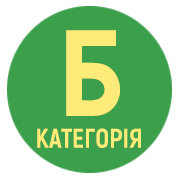COMPARATIVE ANALYSIS OF PHYSICAL DEVELOPMENT INDICATORS OF CHILDREN AGED 11 YEARS WITH VISUAL IMPAIRMENT IN RELATION TO THEIR HEALTHY PEERS AND ACCORDING TO SUBGROUPS OF A SPECIAL MEDICAL GROUP
Abstract
Studying the specifics of physical development and physical fitness of children with visual impairments, researchers determine that representatives of this nosology are characterized by significant deviations in anthropometric indicators. Scientists note that children with visual impairment have significant difficulties with spatial orientation, minimizing their motor activity, which causes a delay in physical development. Purpose of the article is a comparative analysis of physical development indicators of 11-year-old children with visual impairment, according to a special medical group and in comparison with their relatively healthy peers. The research study involved 20 children. Of these 10 children with visual impairment, namely 5 children were assigned to subgroup A and 5 to subgroup B. Also, 10 relatively healthy children took part in the study. Checking the results of measuring physical development indicators in a group of relatively healthy 11-yearold children and visually impaired children for normality showed that all representatives of the studied indicators, except for chest excursion, are similar to normal in terms of frequency distribution. Conducting a comparative analysis of the presented indicators in the groups of 11-year-old children with visual impairment and their relatively healthy peers, we note that for some of them children with visual impairment exceed their peers in terms of body weight and length in absolute and sigmal values. Thus, summarizing the physical development of 11-year-old children with visual impairment, we note that they have higher than normal body length, a developed chest, but moderate excursion. This means that there are children with different levels of respiratory system development. Children with visual impairment are significantly shorter in height and have a significantly lower chest volume compared to their relatively healthy peers. Also, most visually impaired children have a body weight that exceeds the norm for their age, which may indicate either active physical development, which is unlikely, or an unbalanced, unhealthy diet. It is in terms of body weight that children with visual impairment differ from their relatively healthy peers. The results of the scientific study demonstrated that all anthropometric indicators of the representatives of subgroup A exceeded those of subgroup B. The most pronounced was the excursion indicator, which was significantly higher than that of subgroup B.
References
2. Буховець Б.О., Романенко С.С., Покропивний О.М. Особливості фізичного розвитку у дітей з депривацією зору. Rehabilitation & Recreation. 2023. 14. С. 186–192. https://doi.org/10.32782/2522-1795.2023.14.22.
3. Буховець Б., Дишель Г. Специфіка показників фізичного розвитку дітей шкільного віку з порушенням зору. Фізичне виховання, спорт і культура здоров’я у сучасному суспільстві. 2023. № 1(61). С. 23–28. https://doi.org/10.29038/2220-7481-2023-01-23-27.
4. Буховець Б.О., Підгірний О.В. Функціональний стан рівноваги дітей 10 років із депривацією зору. OLYMPICUS. 2023. № 3. С. 28–34. https://doi.org/10.24195/olympicus/2023-3.5.
5. Григус І., Нагорна О., Примачок Л., Небова Н., Ніколенко О. Етапи реалізації програми фізичної реабілітації слабозорих та незрячих дітей дошкільного віку. Молодіжний науковий вісник Східноєвропейського національного університету імені Лесі Українки. Фізичне виховання і спорт. 2018. 31. С. 55–60.
6. Кашуба В., Савлюк С Біологічні передумови розробки концепції формування просторової організації тіла дітей 6–10 років із депривацією зору. Journal of Education, Health and Sport. 2017. № 7 (7). С. 1095–1112.
7. Рядова Л.О. Кореляційний зв’язок показників стійкості вестибулярного аналізатора та диференціювання просторових і часових параметрів рухів у слабозорих учнів основної школи. Фізичне виховання та спорт. 2023. № 3. С. 41–48. https://doi.org/10.26661/2663-5925-2023-3-06.
8. Коваленко Ю., Голець В. Особливості застосування оздоровчих систем у фізичному вихованні школярів. Фізичне виховання та спорт. 2019. № 2. С. 42–47.
9. Savluyk S. Conceptual basis of the concept of spatial organization of body of children 6–10 years with sensor systems deprivation in the process of physical education. Фізичне виховання, спорт і культура здоров’я у сучасному суспільстві. 2017. № 3 (39). С. 180–185.
10. Savliuk S., Kashuba V., Vypasniak A., Kindrat P., Grygus I., Vakoliuk A., Panchuk I., Hagner-Derengowska M. Differentiated approach for improving the physical condition of children with visual impairment during physical education. Journal of Physical Education and Sport. 20(2). 2020. Р. 958–965. doi: 10.7752/jpes.2020s2136.
11. Kirk T.N., Haegele J.A., Zhu X. Developing physical education skills in individuals with visual impairments: An exploratory study. Physics Educator. 80(3). 2023. С. 278–294. https://doi.org/10.18666/TPE-2023-V80-I3-11582.
12. Veldhors C., Vervloed M., Kef S., Steenbergen B. A scoping review of longitudinal studies of children with vision impairment. British Journal of Visual Impairment. 41(3). Р. 587–609. https://doi.org/10.1177/02646196211072432
13. Міністерство науки і освіти України. 2023. URL: https://mon.gov.ua/ua/osvita/zagalna-serednya-osvita/navchannya-ditej-uspecialnih-zakladah-osviti/osvita-ditej-z-osoblivimi-potrebami/navchalni programi/korekcijni-programi/programi-z-korekcijno-rozvitkovoyi-roboti-dlya-ditej-z-porushennyami-zoru.
PDF Downloads: 56






